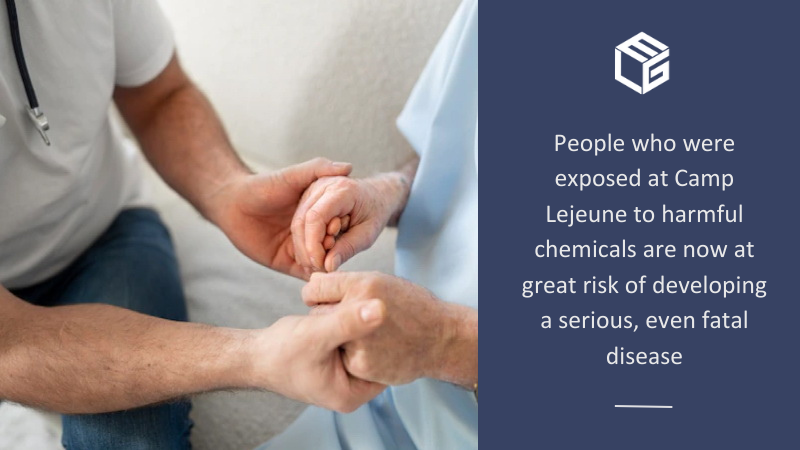It is estimated that over 500K of the Marines and family members who spent time at Camp Lejeune will get sick
One of the most severely contaminated sites at Camp Lejeune was the Tarawa Terrace military housing area, where toxic chemicals improperly disposed of by ABC One-Hour Cleaners, a dry-cleaning firm, were lurking.
Furthermore, Hadnot Point was contaminated with dangerous chemicals from multiple sources, such as leaking underground storage tanks, industrial area spills, and leakage from a toxic waste dump.
According to researchers, the level of toxic chemicals polluting the environment of Camp Lejeune was between 240 and 3,400 times higher than the safe limit.
Over one million military personnel and their family members were stationed at Camp Lejeune between 1953 and 1987, numerous of whom came to struggle with terrible health problems as a result of toxic exposure. Dangerous chemicals present at Camp Lejeune during the last century:
Claims/lawsuits eligibility for Camp Lejeune water contamination victims
On August 11, 2022, the Camp Lejeune Justice Act was signed into law by President Joe Biden, allowing everyone who spent time at the military base between August 1, 1953, and December 31, 1987, for at least 30 consecutive days to obtain compensation from the government.
The CLJA is now part of the Honoring Our PACT Act, which is perhaps the largest healthcare and benefit expansion in VA history.
It expands the eligibility of veterans affected by toxic exposure, adds over 20 new presumptive diagnoses, and requires the VA to offer a toxic exposure screening to each veteran enrolled in its healthcare system. In addition to receiving financial compensation under the Camp Lejeune Justice Act, veterans can also receive money from the VA.
They can apply for VA disability benefits, which can be as high as $3,000 per month if they have a disability rating of 100%. If they are severely disabled and need the assistance of another person to perform daily tasks, Camp Lejeune Veteran Marines can also apply for Special Monthly Compensation.
We encourage veterans, reservists, and guardsmen who have been stationed at Camp Lejeune and developed a disease to contact our attorneys. They will help file a water contamination claim/lawsuit and a VA claim so that you can receive the maximum financial compensation you are entitled to, as well as VA benefits. However, to qualify for filing a Camp Lejeune water contamination claim/lawsuit, you must meet the following eligibility criteria as a former military member:
- you must have been stationed at Camp Lejeune between August 1, 1953, and December 31, 1987
- you must have spent at least 30 consecutive days at Camp Lejeune during that period
- you must have one of the linkable diseases
- you must retrieve your military records and your medical records
- you must not have received a dishonorable discharge from the military
At the moment, roughly 38,769 family members of military personnel live at Camp Lejeune. We know that money cannot offer a cure for the serious, often life-threatening health problems these people came to struggle with as a result of toxic exposure. Still, we advise family members to take legal action, too, as the financial compensation they can receive will make access to quality healthcare and treatment significantly easier. These are the eligibility criteria they must meet to file a Camp Lejeune toxic water claim or a VA claim:
- you must have been stationed at Camp Lejeune between August 1, 1953, and December 31, 1987
- you must have spent at least 30 consecutive days at Camp Lejeune during that period
- you must have one of the linkable diagnoses
- you must retrieve your medical records, which must clearly explain the link between your diagnosis and toxic exposure
- you must provide us with proof of having lived at Camp Lejeune, such as utility bills, base housing records, military orders, or tax forms
- you must send our Camp Lejeune lawyers a document proving your relationship to the Veteran Marine whom you were stationed with, such as a marriage license, birth certificate, or adoption papers
- your treating physician must complete the Camp Lejeune Family Member Program Treating Physician Report
Diseases you can develop following toxic exposure at Camp Lejeune
Because the chemicals present at Marine Corps Base Camp Lejeune are highly toxic to the human organism, Marines, their family members and civilians who were exposed are now at great risk of developing a serious, even fatal disease as a result of exposure.
When it comes to cancer, misdiagnosis is very common, as the symptoms of the disease often resemble the signs of more common and less serious health problems.
For this reason, we strongly advise you to seek a second opinion from a medical specialist, as you may have received a wrong diagnosis. Not only will a correct diagnosis qualify you for recovering compensation by filing a Camp Lejeune toxic water claim/lawsuit, but it will also help you receive timely and appropriate treatment for your health problem.
The following are the diseases and health issues associated with exposure to the toxic agents present at Camp Lejeune. The list contains the presumptive diagnoses and other possible afflictions as well:
Camp Lejeune presumptive service connection
The VA presumes that certain diseases occurring in Camp Lejeune Marines were directly caused by their military service, specifically by drinking contaminated water at the military base. These diagnoses are known as presumptive conditions.
Because the VA assumes that these health problems have a strong association with military service, veterans who intend to file a claim do not have to prove the connection between their illness and their time spent at Camp Lejeune.
The following are the presumptive diagnoses for which you can file a VA claim:
- bladder cancer
- kidney cancer
- liver cancer
- adult leukemia
- non-Hodgkin's lymphoma
- multiple myeloma
- Parkinson’s disease
- aplastic anemia
- myelodysplastic syndromes
- esophageal cancer
- miscarriage
- neurobehavioral effects
- breast cancer (male/female)
- lung cancer
- female infertility
Our attorneys can help you file a Camp Lejeune wrongful death claim
Unfortunately, many Camp Lejeune veterans avoid seeking the compensation they deserve because of their fear of a long and complex legal process, and many pass away before they can even take legal action. Still, if you have a family member who was a Camp Lejeune veteran and died of a disease caused by drinking toxic water at the military base, we encourage you to contact our attorneys, as you might be able to file a wrongful death claim to recover compensation on their behalf. The money you can obtain can help you with past medical expenses and funeral expenses.
Therefore, if you lost a family member who was a Camp Lejeune veteran and had not filed a claim to obtain compensation, we might be able to help you file a wrongful death claim, so do not hesitate to contact our law firm. With over 30 years of experience in handling toxic exposure claims, we will go to great lengths to recover the maximum compensation available on behalf of your deceased loved one if we determine that you are eligible. Our law firm works on a contingency fee basis, so you will not have to pay anything out of pocket unless we obtain money for you.
Testimonials of people who developed serious diseases as a consequence of staying at Camp Lejeune
Since over 1 million people and their family members were exposed to the toxic agents present at Camp Lejeune over a period of 30 years, numerous of these individuals sought financial compensation for the awful, even life-threatening diseases they came to struggle with, including from our law firm. The following are only some of the cases our skillful attorneys have pursued so far to recover fair benefits for veterans and their family members.
The woman, a mother of two, came to struggle with leukemia for 2 years while staying at Camp Lejeune with her husband, who was in the U.S. Marine Corps at the time. She is 46, and, after experiencing a series of distressing symptoms, including fever, severe weight loss, fatigue, and swollen lymph nodes, she sought medical attention. After several weeks, she received her leukemia diagnosis, which was stage 3. "We had no idea that the site was contaminated, and everyone who was staying with us was exposed. I would have never imagined what this will turn into for me and my family.", she says.
After spending 8 months at Camp Lejeune in 1964, William Smith, age 67, developed kidney cancer, which was very advanced when he was diagnosed. "Nobody warned us about the chemicals; we were clueless", he recalls. The man decided to take legal action to recover the compensation he was entitled to for his awful diagnosis, and our attorneys recovered a substantial sum of money on his behalf. Unfortunately, because his disease is so advanced, surgery is not a viable treatment option for William Smith, who is currently receiving palliative care.
As a veteran who served in the U.S. Marine Corps between 1954 and 1968, Thomas Ramirez was stationed at Camp Lejeune for 4 years. Today, he is struggling with lung cancer as a result of exposure to toxic agents. "Somehow, the chemicals reached my lungs, and now I have stage 2 lung cancer. The only good thing about this situation is that my disease was found just in time for me to undergo surgery", he says. Thomas Ramirez decided to take legal action with the help of our skillful attorneys, and now he has enough money to afford to pay his medical expenses.
Richard Blackstone was stationed at Camp Lejeune between 1966 and 1983. Like the majority of people, he also was exposed to chemicals during his stay at the military base, which resulted in liver cancer, a terrible diagnosis with which he is still struggling today. Unfortunately, his disease was discovered in advanced stages, and thereby, medical professionals can only administer him chemotherapy to ease his symptoms, and he is also receiving palliative care. "By the time we found out it was too late for us. I’ve been on base for 17 years, which definitely took a heavy toll on my health", he recalls. Our attorneys also helped him recover the financial compensation he was eligible for, which is a great help with regard to the cost of his healthcare and treatment costs.
As a wife of a U.S. Marine Corps soldier, Michelle Levine developed stage 3 bladder cancer after toxic exposure from Camp Lejeune for 2 years. While her disease was very advanced, she was still eligible for surgery, which gives her hope that her cancer will eventually go into remission. "Nobody knew... I personally know three other people whom I met at Camp Lejeune and who were also diagnosed with cancer", she remembers. Soon after finding out about her disease, she contacted our law firm in the hope of recovering compensation for her diagnosis, as Michelle Levine was struggling financially before receiving the awful news. We were able to provide her with the legal assistance she needed, and now she has enough money to help her with the cost of her cancer treatment.
Today, Benjamin Thompson is a veteran who was also stationed at Camp Lejeune between 1959 and 1962. He was not aware of the dangerous chemicals present in it, and as a consequence, he developed esophageal cancer. "We didn’t know back then. Not in my worst nightmares would I have thought that I will receive such a serious diagnosis. My cancer was only stage 2 when it was found, which made me eligible for surgery, fortunately", he says. Because he needed more money to afford to pay for his medical expenses, Benjamin Thompson decided to reach out to our law firm, which helped him recover the compensation he was entitled to from Camp Lejeune.
As the son of a U.S. Marine Corps soldier, Nicholas Wilson came to develop lymphoma as a consequence of toxic chemical exposure while he and his family were staying at Camp Lejeune between 1958 and 1960. Unfortunately, his disease was very advanced when it was discovered by medical professionals, but he is still eligible for receiving chemotherapy and radiotherapy in the hope of shrinking his tumors. "I was only 12 when my family went to Camp Lejeune by virtue of my father’s occupation. I had no idea and nor did the others that the area was contaminated with over 70 chemicals", he recalls. Because he needed more money for his cancer treatment, he took legal action, and our experienced attorneys helped him receive the compensation he was eligible for.



